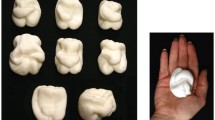Abstract
Using two-dimensional (2D) angles composed of two straight, 8-cm-long arms that formed an angle, we investigated the importance of cutaneous feedback from the exploring index finger, and proprioceptive feedback from the shoulder (scanning movements made with the outstretched arm), to the human ability to discriminate small differences in the angles. Using a two-alternative forced-choice paradigm, subjects identified the larger angle in each pair explored (standard angle, 90°; comparison angles, 91° to 103°). Subjects were tested under four experimental conditions: (1) active touch (reference condition); (2) active touch with digital anaesthesia; (3) passive touch (a computer-controlled device displaced the angle under the subject’s immobile digit); and (4) passive touch with digital anaesthesia. When only proprioceptive feedback from the shoulder was available (condition 2), there was a significant increase in discrimination threshold, from 4.0° in the reference condition (condition 1) to 7.2°, indicating that cutaneous feedback from the exploring digit contributed to task performance. When only cutaneous feedback from the finger was available (condition 3), there was also a significant increase in threshold from 4.2° in the active condition to 8.7°. This suggested that proprioceptive feedback from the shoulder, potentially from a variety of deep (muscle and joint) but also cutaneous receptors, contributed to the ability to discriminate small changes in 2D angles. When both sources of feedback were eliminated (condition 4), subjects were unable to discriminate even the largest difference presented (13°). The results suggest that this sensory task is truly an integrative task drawing on sensory information from two different submodalities and so, following the definition of Gibson, is haptic in nature. The results are discussed in relation to the potential neural mechanisms that might underlie a task that requires integration across two anatomically separate body parts and two distinct modalities.
Similar content being viewed by others
Author information
Authors and Affiliations
Corresponding author
Rights and permissions
About this article
Cite this article
Voisin, J., Lamarre, Y. & Chapman, C.E. Haptic discrimination of object shape in humans: contribution of cutaneous and proprioceptive inputs. Exp Brain Res 145, 251–260 (2002). https://doi.org/10.1007/s00221-002-1118-5
Received:
Accepted:
Published:
Issue Date:
DOI: https://doi.org/10.1007/s00221-002-1118-5




